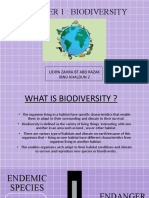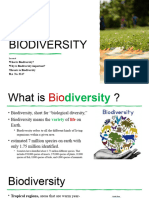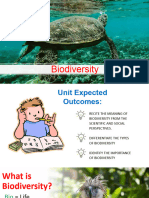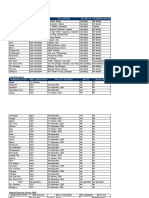Chapter 4 Lesson 2
Chapter 4 Lesson 2
Uploaded by
BjayCopyright:
Available Formats
Chapter 4 Lesson 2
Chapter 4 Lesson 2
Uploaded by
BjayOriginal Description:
Original Title
Copyright
Available Formats
Share this document
Did you find this document useful?
Is this content inappropriate?
Copyright:
Available Formats
Chapter 4 Lesson 2
Chapter 4 Lesson 2
Uploaded by
BjayCopyright:
Available Formats
Name: Bjay Largo Course/Year/Section: BSIT-ELX 2A
CHAPTER 4 – Specific Issues in Science, Technology, and Society
Lesson 2– Biodiversity and the Healthy Society
ACTIVITY
- Fill in the circles below of terms you can associate with Biodiversity. You may also
write the things you want to know about biodiversity. Write below in a bullet form.
BIODIVERSITY
•Species diversity
•Ecosystem diversity
•Genetic diversity
•Endangered species
•Extinction
•Conservation
•Habitat destruction
•Ecosystem services
•Ecological balance
•Keystone species
•Biodiversity hotspots
•Invasive species
•Threatened species
•Ecosystem resilience
•Biogeography
ANALYSIS
Now that we have identified concepts associated with biodiversity, let us figure out the specific
components and benefits we derive from the diverse life forms on earth and we will also identify
areas that are highly diverse. Place your answers below.
Biodiversity components Benefits we derive from a Highly biodiverse areas in
biodiverse environment the country
-Species Diversity -Supports ecosystem - Palawan Island
resilience and stability
- Enables species - Sierra Madre Mountain
- Genetic Diversity adaptation and survival Range
- Ecosystem Diversity - Pollination, water - Samar Island Natural
purification, climate Park
regulation
- Medicine and - Natural compounds for
Pharmaceuticals drugs and treatments -Mount Hamiguitan Range
Wildlife Sanctuary
- Food Resources - Sustains diverse food
sources - Tablas Island
-Ecological Balance - Helps control
populations and - Agusan Marsh Wildlife
interactions Sanctuary
Search available online and printed resources on endemic species of plants and animals in the
Philippines. Read on these unique species. Provide a brief description on the status, habitat,
nutrition, and ecological importance of the species. Attach pictures as well on the box below.
Endemic species of Description Picture
plants/animals
- Tarsier (Tarsius syrichta): - The Philippine Tarsier is
a small, nocturnal
primate found in the
Philippines. It has large,
round eyes and a long
tail, and it feeds on
insects. It is known for
its unique ability to
rotate its head almost
180 degrees.
- Philippine Eagle - Also known as the
(Pithecophaga jefferyi): Monkey-eating Eagle, it
is one of the largest and
most powerful eagles in
the world. This critically
endangered bird is found
only in the Philippines
and is known for its
impressive size and
striking appearance.
Rafflesia (Rafflesia spp.): -
The Rafflesia is a genus
of parasitic flowering
plants found in the
Philippines. They are
known for producing the
largest individual flowers
in the world, some
reaching up to one meter
in diameter.
EASTERN VISAYAS STATE UNIVERSITY
ORMOC CAMPUS
- Is a tropical pitcher plant
-Nepenthes leyte
native to the Philippines.
It appears to be endemic
to the island of Leyte,
after which it is named.
It has been recorded
from submontane mossy
forest at 900 m altitude.
ASSESSMENT
What destroys habitat?
Habitat destruction is primarily caused by various human activities and natural events. Some of
the key factors that contribute to habitat destruction include:
1. Deforestation: The clearing of forests for agriculture, logging, urbanization, and
infrastructure development leads to the loss of critical habitats for numerous plant and
animal species.
2. Urbanization and Infrastructure Development: Expanding cities, roads, highways, and
industrial areas often result in the conversion of natural habitats into concrete landscapes,
disrupting ecosystems.
3. Agriculture: Large-scale agriculture, including monoculture and slash-and-burn practices,
can lead to the destruction of natural habitats to make way for crops and livestock.
4. Mining: Extracting minerals and resources from the Earth can cause significant habitat
destruction and disrupt ecosystems.
5. Pollution: Industrial pollution, waste disposal, and oil spills can contaminate water bodies
and soil, affecting the health of both aquatic and terrestrial habitats.
6. Climate Change: Global warming and its associated impacts, such as rising sea levels and
altered weather patterns, can disrupt and degrade habitats, threatening many species.
7. Invasive Species: Introduction of non-native species to an area can outcompete native
species, altering ecosystems and leading to habitat destruction.
8. Overfishing: Unsustainable fishing practices can deplete fish populations and disrupt
marine habitats.
9. Dam Construction: Building dams and reservoirs can flood large areas of land, leading to
the destruction of natural habitats and displacement of wildlife.
10. Natural Events: Natural disasters like wildfires, earthquakes, volcanic eruptions, and
tsunamis can cause significant habitat destruction.
Habitat destruction is a major driver of biodiversity loss, as it directly affects the ability of
various species to survive and thrive in their natural environments. Conservation efforts and
sustainable practices are essential to minimize habitat destruction and protect the Earth’s
ecosystems and the diversity of life they support.
You might also like
- HSC Biology Module 3 Summary NoteDocument15 pagesHSC Biology Module 3 Summary Notesonia shenNo ratings yet
- 009 RCC Job Procedure 1Document15 pages009 RCC Job Procedure 1Shaarun M RamannNo ratings yet
- Status of the Philippine Biodiversity................Document63 pagesStatus of the Philippine Biodiversity................reychielmaetaypinNo ratings yet
- Philippine TarsierDocument5 pagesPhilippine TarsierYana AldoraNo ratings yet
- Biodiversity PDFDocument78 pagesBiodiversity PDFRaymond LuberiaNo ratings yet
- Chap 8Document55 pagesChap 8autistickidd1No ratings yet
- Learning Activity - Biodiversity and Health SocietyDocument5 pagesLearning Activity - Biodiversity and Health SocietyManoj MudirajNo ratings yet
- Yz ThineDocument19 pagesYz ThineMhel ChieeNo ratings yet
- BiodivesrityDocument27 pagesBiodivesrityJemimah Anne Santos FerrerNo ratings yet
- STS 8-BiodiversityDocument27 pagesSTS 8-BiodiversityRobertson LabanNo ratings yet
- Biodiversity and Conservation: Ms. Jannet Broas Ms. Celeste Desingaño Ms. Gladys Guirre Ms. Jenalyn SampangDocument55 pagesBiodiversity and Conservation: Ms. Jannet Broas Ms. Celeste Desingaño Ms. Gladys Guirre Ms. Jenalyn SampangKaye SolanoyNo ratings yet
- BiodiversityDocument31 pagesBiodiversitySarah MendozaNo ratings yet
- BiodivesrityDocument47 pagesBiodivesrityBenzDave AgsoyNo ratings yet
- M2 Human Role in An EcosystemDocument28 pagesM2 Human Role in An EcosystemMaryann NuñezNo ratings yet
- STS IUCN Red ListDocument2 pagesSTS IUCN Red ListLexter CrudaNo ratings yet
- C3 - Biodiversity at The Species LevelDocument27 pagesC3 - Biodiversity at The Species LevelShawn BlueNo ratings yet
- Biodiversity and Its ConservationDocument32 pagesBiodiversity and Its ConservationRani KumariNo ratings yet
- Group 8 HW3 Environmental ScienceDocument21 pagesGroup 8 HW3 Environmental ScienceVy NguyễnNo ratings yet
- Endemic: Species of PlantsDocument15 pagesEndemic: Species of PlantsKristian Bernard PaanoNo ratings yet
- EBS 42L - Lesson 1 - 2019-2020Document99 pagesEBS 42L - Lesson 1 - 2019-2020Chel SyNo ratings yet
- Cardeno - Assessmen 2Document14 pagesCardeno - Assessmen 2reygie cardenoNo ratings yet
- Saving The Philippine Eagle As A Way of Saving The Nation'S FreedomDocument5 pagesSaving The Philippine Eagle As A Way of Saving The Nation'S FreedomJinky FernandezNo ratings yet
- Species Commonly Selected For Culture: Labeo RohitaDocument4 pagesSpecies Commonly Selected For Culture: Labeo RohitaJennyca RoaNo ratings yet
- Script Bio VlogDocument2 pagesScript Bio Vlogfrenzrovinnunez10No ratings yet
- Forest BiodiversityDocument27 pagesForest BiodiversityJefferson HimsonNo ratings yet
- WALADocument5 pagesWALAJohn Marines EstiocoNo ratings yet
- Unit 4 Biodiversity & ConservationDocument39 pagesUnit 4 Biodiversity & Conservationakshitarana98960No ratings yet
- Ecoregions in The PhilippinesDocument4 pagesEcoregions in The PhilippinesMira Lei MarigmenNo ratings yet
- Endangered Species LECTUREDocument73 pagesEndangered Species LECTUREViverly Joy De GuzmanNo ratings yet
- ECO 522 - WILDLIFE ECOLOGY AND CONSERVATION - CopyDocument14 pagesECO 522 - WILDLIFE ECOLOGY AND CONSERVATION - Copymalmustapha162No ratings yet
- 3 EnvironmentDocument12 pages3 EnvironmentDavlatbekNo ratings yet
- Concept Mapping: Group 5Document10 pagesConcept Mapping: Group 5John Rey MontemorNo ratings yet
- Environmental Protection NSTPDocument42 pagesEnvironmental Protection NSTPxirbcia0308No ratings yet
- Week - 15 Biodiversity SynchronousDocument49 pagesWeek - 15 Biodiversity SynchronousGlaiza VillaverNo ratings yet
- Biomes and BiodiversityDocument41 pagesBiomes and BiodiversityJordaliza BuyagaoNo ratings yet
- Dailo - BSTRM1-1D (#14)Document2 pagesDailo - BSTRM1-1D (#14)Laica Mae R DailoNo ratings yet
- Chapter 1: Biodiversity: Lidiya Zahra BT Abd Razak Ibnu Khaldun 2Document25 pagesChapter 1: Biodiversity: Lidiya Zahra BT Abd Razak Ibnu Khaldun 2Lidiya ZahraNo ratings yet
- Environment Vocabulary ListDocument8 pagesEnvironment Vocabulary ListClaudia Macarie100% (3)
- Wildlife Biodiversity ConservationDocument3 pagesWildlife Biodiversity ConservationPegNo ratings yet
- Wildlife Conservation - SCI PROJECTDocument21 pagesWildlife Conservation - SCI PROJECTanjalipathak213No ratings yet
- BiodiversityDocument17 pagesBiodiversityswainananta336No ratings yet
- Envisci Lesson 6 BiodiversityDocument38 pagesEnvisci Lesson 6 BiodiversityMariaNo ratings yet
- BiodiversityDocument2 pagesBiodiversityNIKHIl vermaNo ratings yet
- M9 Learning ActivityDocument5 pagesM9 Learning ActivityMaria Louella MagadaNo ratings yet
- Raus CSP20 E&B 4 Test 39 SDocument22 pagesRaus CSP20 E&B 4 Test 39 SRIJU ROYCHOWDHURYNo ratings yet
- Endangered Species TranscriptDocument5 pagesEndangered Species TranscriptJerric CristobalNo ratings yet
- Floaura and Fauna in DNP 2Document3 pagesFloaura and Fauna in DNP 2Badar ShahzadNo ratings yet
- A Biotic Community Lives in An Environment, Which Provides Material, Energy Requirement and Other Living Conditions To It. "An EcologicalDocument9 pagesA Biotic Community Lives in An Environment, Which Provides Material, Energy Requirement and Other Living Conditions To It. "An EcologicalMaria Victoria IgcasNo ratings yet
- Myka ScienceDocument14 pagesMyka ScienceMJ AndrabadoNo ratings yet
- Threatened and Endemic Wildlife of The PhilippinesDocument4 pagesThreatened and Endemic Wildlife of The PhilippinesGea May BrillantesNo ratings yet
- Habitat and Adaptation: Structural Adaptation, Just As The Limbs of BirdsDocument1 pageHabitat and Adaptation: Structural Adaptation, Just As The Limbs of BirdsGatcha GamesNo ratings yet
- UntitledDocument22 pagesUntitledCamarodin SumandalNo ratings yet
- Carlito SyrichtaDocument4 pagesCarlito Syrichtatbm8ghdcb5No ratings yet
- Wildlife BMP Presentation 4-07-2021Document67 pagesWildlife BMP Presentation 4-07-2021Meera KhalilNo ratings yet
- CONSERVATION OF PLANTS AND ANIMALS - NotesDocument3 pagesCONSERVATION OF PLANTS AND ANIMALS - NotesNiraj SethiNo ratings yet
- SBIO - Introduction To BiodiversityDocument66 pagesSBIO - Introduction To BiodiversitymmballesterosNo ratings yet
- Biodiversity 1Document22 pagesBiodiversity 1Krish BagNo ratings yet
- Class 7 Science: Conservation of Plants and AnimalsDocument21 pagesClass 7 Science: Conservation of Plants and AnimalsJ CNo ratings yet
- AmpibiansDocument3 pagesAmpibiansRhea Jean BeresoNo ratings yet
- Biodiversity NotesDocument13 pagesBiodiversity NotesnagabhushanaatNo ratings yet
- Proposal Format For Student - 11-10-2022Document4 pagesProposal Format For Student - 11-10-2022BjayNo ratings yet
- MistahDocument4 pagesMistahBjayNo ratings yet
- Experiment 6Document2 pagesExperiment 6BjayNo ratings yet
- Chapter 4 Lesson 3Document5 pagesChapter 4 Lesson 3BjayNo ratings yet
- Chapter 4 Lesson 4Document5 pagesChapter 4 Lesson 4BjayNo ratings yet
- Safety Data Sheet: Urea SolutionDocument6 pagesSafety Data Sheet: Urea SolutionReCyoNo ratings yet
- SCHEME Physical GeographyDocument12 pagesSCHEME Physical Geographyunderdawg992No ratings yet
- Manual For Agrohydrology AND Engineering Design For Small Water Impounding Project (Swip)Document46 pagesManual For Agrohydrology AND Engineering Design For Small Water Impounding Project (Swip)macky salacupNo ratings yet
- Hydropower: The Hashemite UniversityDocument24 pagesHydropower: The Hashemite Universityلينا جودةNo ratings yet
- Sunamganj Drainage Layout and DetailsDocument1 pageSunamganj Drainage Layout and DetailsMirajul AnwarNo ratings yet
- Drainage BasinsDocument18 pagesDrainage BasinsSyeda moosviNo ratings yet
- J.ijsrc.2021.02.002 040159Document10 pagesJ.ijsrc.2021.02.002 040159dododiahNo ratings yet
- Fdocuments - in - The Status of Soil Resources in Mozambique Fao Status of Soil Resources in MozambiqueDocument21 pagesFdocuments - in - The Status of Soil Resources in Mozambique Fao Status of Soil Resources in MozambiqueEloi Carlos GoveNo ratings yet
- Eco Sensitive ZonesDocument28 pagesEco Sensitive ZonesAnima JainNo ratings yet
- Deepwater Well ControlDocument2 pagesDeepwater Well ControlJayaprakash Gopala KamathNo ratings yet
- WW Abcd Formula - 0Document6 pagesWW Abcd Formula - 0Ahmad Usman TahirNo ratings yet
- Module III Lesson 4 Env Impact AssessmentDocument26 pagesModule III Lesson 4 Env Impact Assessmentdilja aravindanNo ratings yet
- y4 Sst Mid Term Review Unsolved 2024-2025Document11 pagesy4 Sst Mid Term Review Unsolved 2024-2025Abdบllaђ SђafᎥq Raηa 6 - ANo ratings yet
- BÀI TẬP ÔN TẬP KIỂM TRA GIỮA KÌ I LỚP 12 THÍ ĐIỂM hsDocument8 pagesBÀI TẬP ÔN TẬP KIỂM TRA GIỮA KÌ I LỚP 12 THÍ ĐIỂM hsvan.nt00958No ratings yet
- Plastic Waste Management Shani ShingnapurDocument34 pagesPlastic Waste Management Shani Shingnapuruday xeroxNo ratings yet
- Hempaline Prepare 130Document2 pagesHempaline Prepare 130CRISTIAN SILVIU IANUCNo ratings yet
- New CBR FormetDocument1 pageNew CBR FormetmdfatikaliNo ratings yet
- Municipality/City Disposal Facility DF Location DF Status DF RehabilitationDocument3 pagesMunicipality/City Disposal Facility DF Location DF Status DF RehabilitationsorbisorbiNo ratings yet
- Answer The Following Questions: TC 0.0078 (L 3/h) 0.385Document6 pagesAnswer The Following Questions: TC 0.0078 (L 3/h) 0.385Kareem TaherNo ratings yet
- Types of Hydropower TurbinesDocument3 pagesTypes of Hydropower TurbinesRahul ChandrawarNo ratings yet
- Daftar Pustaka: Pengolahan Air PDAM Ibukota Kecamatan Prambanan Kabupaten KlatenDocument2 pagesDaftar Pustaka: Pengolahan Air PDAM Ibukota Kecamatan Prambanan Kabupaten Klatenizzati istiharaNo ratings yet
- CORALations - ACE - Gmail - San Juan Harbor Dredge - Condado Lagoon FillDocument2 pagesCORALations - ACE - Gmail - San Juan Harbor Dredge - Condado Lagoon FillCORALationsNo ratings yet
- Dao 2022 04Document13 pagesDao 2022 04Raymund Joshua Pre�aNo ratings yet
- JICA Report Initial Environmental AssessmentDocument42 pagesJICA Report Initial Environmental Assessmentfranz ramosNo ratings yet
- 2d - RS Rotary Air Blower PDFDocument6 pages2d - RS Rotary Air Blower PDFHoàn Đức VinhNo ratings yet
- HS Earth Science Chapter 20 Power PointDocument36 pagesHS Earth Science Chapter 20 Power PointMichael McPeakNo ratings yet
- Population Forecast: The Population of Three DecadesDocument8 pagesPopulation Forecast: The Population of Three DecadesaejazNo ratings yet
- Safety Data Sheet: SECTION 1: Identification of The Substance/mixture and of The Company/undertakingDocument12 pagesSafety Data Sheet: SECTION 1: Identification of The Substance/mixture and of The Company/undertakingMainrajNo ratings yet
- Abhi Kohler Toh BrochureDocument236 pagesAbhi Kohler Toh BrochureHabi JeshinderNo ratings yet






























































































